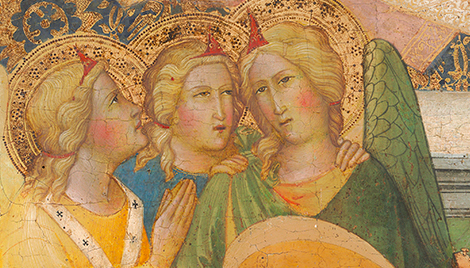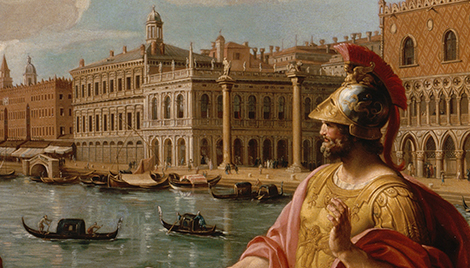Kress Grantee Spotlight: Michelle DiMarzo, Fairfield University Art Museum
Michelle DiMarzo, PhD, is Curator of Education and Academic Engagement at the Fairfield University Art Museum in Fairfield, CT. She is an alumna of Fairfield University, graduating with a B.A. in Art History and English before pursuing graduate degrees in Art History, specializing in Italian Renaissance visual art. She received her PhD from Temple University, and during graduate school held the Phyllis G. Gordan/Samuel H. Kress Foundation Two-Year Pre-doctoral Rome Prize at the American Academy in Rome. Dr. DiMarzo is also Assistant Professor in Art History & Visual Culture in the Department of Visual & Performing Arts, where she teaches courses in Renaissance art and the Museum Exhibition Seminar. Among the exhibitions Dr. DiMarzo has curated at the museum are The Artist Collects: Highlights of the James Reed Print Collection (2019); Prints from the Age of Rodin (2019); and Out of the Kress Vaults: Women in Sacred Renaissance Painting (2023).
Read on to hear more about Michelle’s work and the Fairfield University Art Museum’s recent Kress-funded exhibition, Out of the Kress Vaults, in conversation with Shea Spiller (Fairfield University, '17) from the Kress Foundation.
Carey Mack Weber (Frank and Clara Meditz Executive Director, Fairfield University Art Museum), Max Marmor (President, Kress Foundation), and Michelle DiMarzo at the opening of Out of the Kress Vaults
Shea Spiller: Hi, Michelle. Thank you so much for taking the time to speak with me today. To start, what is your current position?
Michelle DiMarzo: I’m the Curator of Education and Academic Engagement at the Fairfield University Art Museum, and Assistant Professor of Art History and Visual Culture in the Visual and Performing Arts Department at Fairfield University. It’s a very long mouthful.
SS: How did it feel as a Fairfield alum coming back to campus in this new capacity?
MD: It’s been relatively easy to compartmentalize my professional life from my student days, especially because the museum wasn’t even here when I was a student! The museum was only in the early idea stages when I was a senior. I often like to remind visitors, whether students or members of the larger community, that there was a time not too long ago when the physical space of the museum was file storage—and it’s actually where I had my first work study job. I remind students of this to underscore the importance of questioning the history of a space. You can’t assume that something has always been the way it is now.
Art history encourages us to think about the history of institutions and objects. Even something as simple as recognizing that, yes, this used to be a dusty basement and this is what it can be, can hopefully inspire the university to think about what more the museum could be, if we were to broaden our horizons a little more.
Out of the Kress Vaults: Women in Sacred Renaissance Painting, on view September 16-December 17, 2022
SS: I'd love to spend some time talking about Out of the Kress Vaults: Women in Sacred Renaissance Painting, which was such a wonderful exhibition. Can you give an overview of the exhibition and some background on how it came about?
MD: The museum’s director, Carey Mack Weber, suggested the idea of borrowing one or two Kress works from another museum to put in conversation with our existing Kress collection. It then grew into a larger exhibition and one that involved participation by Fairfield students. I had successfully added a new course to the university curriculum, the Museum Exhibition Seminar, and we thought it would be great to have students work on an upcoming exhibition so that they could see through all the various stages. The seminar ran in the spring of 2021 with seven students, a mix of art history majors and non-majors, and they did incredible work. I also taught an Italian Renaissance art course while the show was on view in the fall of 2022, so I could use it as a teaching tool in that way as well.
The students came up with proposals for an exhibition of Kress works based on a spreadsheet created by Bill Eiland, the former director of the Georgia Museum of Art, that documented the entire Kress Collection and noted whether they were on view or in storage. The initial idea was to exhibit works that were currently in storage at institutions in the northeast, though we expanded that criteria a bit.
Several students had ideas for fantastic exhibitions that just would not work logistically. For example, a bio-chem major in the class really wanted to do a show focused on a fresco cycle at the National Gallery of Art, not realizing that those frescoes are cemented onto the wall and cannot travel. The final theme of women in sacred Renaissance paintings came out of a couple different proposals, which was a great result as it made the exhibition truly a collaborative effort, rather than the sole idea of one individual.
The exhibition explored representations of femininity and virtue in Italian Renaissance paintings of the Virgin Mary, female saints, and nuns. The Kress works we included ranged from small, devotional images intended for the highly gendered spaces of the Renaissance home, to large altarpieces originally on display in churches.
Cover for the digital exhibition catalogue
SS: What a great opportunity for students to participate in all the aspects of creating a museum exhibition. Do you plan on having other student co-organized exhibitions in the future?
MD: Yes! We have one student who was a member of the Kress Seminar and later became our intern, who recently curated her own show (on view until July 15, 2023). It’s entitled In Their Element(s): Women Artists Across Media and focuses on contemporary art by women artists. Her interest in curating came directly out of her experience in the seminar.
There will be another seminar this fall where students will once again be working on an upcoming exhibition. This next exhibition will focus on a group of Old Master prints from Connecticut College and we will be borrowing the collection for two years, so students in the seminar will be able to work directly with the objects that will be in the show.
Nick Shifrin, Fairfield alum (class of '06) and owner of Level FAS, installing exhibition obejcts
SS: What were one or two of your favorite artworks from the Kress exhibition?
MD: The El Greco from the National Gallery was a huge favorite. It’s such a lovely work, even though it’s technically an unfinished painting. The painting that surprised me the most was the Bernardino Fungai from the Lowe Art Museum in Miami. We didn’t truly realize what a massive painting it is until we saw it in person, and the photographs we saw of the work ahead of time also weren’t ideal, which made it even more incredible to finally see in person. I ended all of my tours with that painting!
On the right, the large Bernardino Fungai painting, Madonna and Child with Saints and Angels (circa 1510-1515)
SS: Now that some time has passed since the exhibition closed, what do you view as some of the main successes to come from that show?
MD: One of the things we're most proud of is how robust the faculty engagement was with the show. We had more class groups visit than we have for any other show since I began working here. I really think the fact that it was co-curated by Fairfield students drew both professors and students to the exhibition. I hope to keep that kind of level of collaboration going in the future.
One professor in particular, Karen Langton, is a Visiting Assistant Professor in Religious Studies who teaches a course on gender and sexuality in the Hebrew Bible. Even though Out of the Kress Vaults was comprised entirely of New Testament Christian imagery, she was really excited about the exhibition and did a fabulous job connecting the artworks to Judaism through themes of feminism and the roles of women in religion. She ended up visiting three times with her students—this is exactly the kind of collaboration and engagement that we hope for.
Michelle speaking to a group of Fairfield students in the galleries
SS: That’s really wonderful to hear! Now to pivot away from Out of the Kress Vaults, you were a Kress fellow at the American Academy in Rome. Can you talk a bit about your experience living and working in Rome?
MD: Yes, I had a fantastic experience at the Academy as a recipient of the Phyllis G. Gordan/Samuel H. Kress Foundation Two-Year Pre-doctoral Rome Prize.
My dissertation topic has sometimes caught people by surprise because I worked on Titian, who is a Venetian artist, but I was specifically looking at his time in Rome in the 1540s. I could not have finished my dissertation without the support that was provided at the Academy by the Kress Foundation; it just was an incredible experience.
SS: To zoom out a bit as we wrap up, where do you see opportunities for innovation or growth in your work? What are you most excited about in looking to the future?
MD: The thing that excites me most dramatically and that animates our entire staff is the very real prospect that there will be a significant expansion to the museum in the future. We have fully outgrown our small space and in order for us to take important steps towards growing our collection and having opportunities for students to do more of what they did with Kress show, we just need more room in which to actually grow! So that is absolutely the number one thing that I'm looking forward to in the future.
As an academic art museum, I’m most excited to continue giving students opportunities to engage with the museum – not just as visitors, but as interns and within other capacities where they can see the different roles and career paths available within museums and the cultural sector at large.
I truly could not have imagined as an undergraduate that I would be handling Italian Renaissance prints, or watching a painting that I borrowed from across the country be put up on the wall, because that was not yet on the horizon of what was possible here at Fairfield. But now we've done it! So the question people are already asking us is, what's next? We hope to have exciting answers to those questions.
SS: Well, I can't wait to see how the museum continues to grow! It sounds like it's a very exciting moment before so much change and expansion. Thank you again for taking the time to speak with me today!
For more information on Out of the Kress Vaults—including a virutal tour, digital exhibition catalogue, and audio guide—visit the exhibition page on the Fairfield University Art Museum's website!



